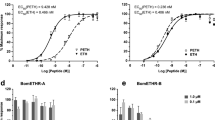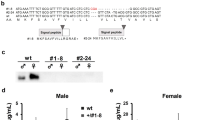Abstract
IN 1924, Watanabe1 postulated that silkworm eggs overwinter as a result of receiving an ‘inhibitory’ substance from the mother moths, but the existence of the substance has not hitherto been substantiated experimentally. On the other hand, I have found2 that the subœsophageal ganglion of the silkworm is responsible for the hibernation of silkworm eggs; but the organ that furnishes the active principle was not known. Evidently diapause of the silkworm is controlled by a hormone, similarly to the moulting or metamorphosis of insects. I attributed3 the diapause of silkworm eggs solely to the function of the subœsophageal ganglion, the brain having no effect, whereas Fukuda4 ascribed the activity of the subœsophageal ganglion to brain regulation by way of the œsophageal connectives. Thus in both hypotheses the subœsophageal ganglion is regarded as the actual source of the principle leading to the production of diapause eggs. It was not known whether the substance secreted from the subœsophageal ganglion—the diapause hormone—is identical with the inhibitory substance suggested by Watanabe or not.
This is a preview of subscription content, access via your institution
Access options
Subscribe to this journal
Receive 51 print issues and online access
$199.00 per year
only $3.90 per issue
Buy this article
- Purchase on Springer Link
- Instant access to full article PDF
Prices may be subject to local taxes which are calculated during checkout
Similar content being viewed by others
References
Watanabe, K., Bull. Seric. Exp. Stat., 6, 9 (1924) (in Japanese).
Hasegawa, K., Gizyutu-siryo, Depart. Agric. For., 29 (1950) (in Japanese).
Hasegawa, K., J. Fac. Agric. Tottori Univ., 1, 2 (1952).
Fukuda, S., Proc. Jap. Acad., 27, 9 (1951).
Hasegawa, K., Bull. Seric. Exp. Stat., 11, 3 (1943) (in Japanese).
Karlson, P., Vehr. deutsch. Zool. Ges. (1954).
Williams, C. M., Nature, 178, 212 (1956).
Author information
Authors and Affiliations
Rights and permissions
About this article
Cite this article
HASEGAWA, K. The Diapause Hormone of the Silkworm, Bombyx mori . Nature 179, 1300–1301 (1957). https://doi.org/10.1038/1791300b0
Issue Date:
DOI: https://doi.org/10.1038/1791300b0
This article is cited by
-
Modelling diapause in mosquito population growth
Journal of Mathematical Biology (2019)
-
Effects of transgenic overexpression of diapause hormone and diapause hormone receptor genes on non-diapause silkworm
Transgenic Research (2017)
-
De novo transcriptome sequencing and analysis of Coccinella septempunctata L. in non-diapause, diapause and diapause-terminated states to identify diapause-associated genes
BMC Genomics (2015)
-
Earthworms as agents for ecotoxicity in roxarsone-contaminated soil ecosystem: a modeling study of ultrastructure and proteomics
Environmental Science and Pollution Research (2015)
-
The regulation of trehalose metabolism in insects
Experientia (1996)
Comments
By submitting a comment you agree to abide by our Terms and Community Guidelines. If you find something abusive or that does not comply with our terms or guidelines please flag it as inappropriate.



